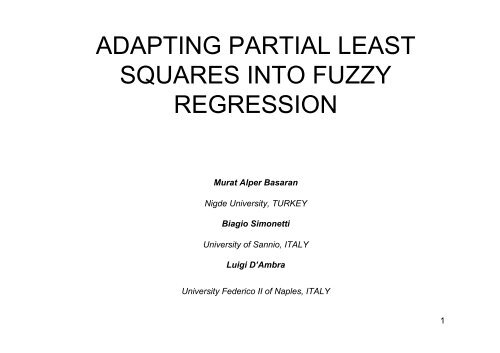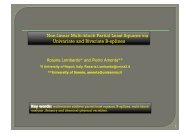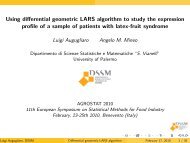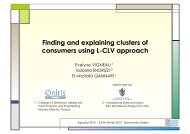adapting partial least squares into fuzzy regression - Agrostat 2010
adapting partial least squares into fuzzy regression - Agrostat 2010
adapting partial least squares into fuzzy regression - Agrostat 2010
Create successful ePaper yourself
Turn your PDF publications into a flip-book with our unique Google optimized e-Paper software.
ADAPTING PARTIAL LEAST<br />
SQUARES INTO FUZZY<br />
REGRESSION<br />
Murat Alper Basaran<br />
Nigde University, TURKEY<br />
Biagio Simonetti<br />
University of Sannio, ITALY<br />
Luigi D’Ambra<br />
University Federico II of Naples, ITALY<br />
1
Outline<br />
• Brief Information on Partial Least Squares (PLS).<br />
• Brief Information on Fuzzy Set Theory (FST)<br />
• Fuzzy Linear Regression (FLR).<br />
• Illustrating the necessity of FLR with data as an<br />
alternative modeling.<br />
• Illustration of PLS based FLR using data set.<br />
• Conclusion<br />
2
Partial Least Squares (PLS)<br />
• Applied to multiple and multivariate cases.<br />
• The main objective is to reduce the dimension of data.<br />
• The components are constructed which are the linear combination of<br />
original independent variables.<br />
• Based on the constructed components, <strong>regression</strong> equation is<br />
developed.<br />
3
Fuzzy Set Theory (FST)<br />
• Introduced by Zadeh in 1965 to model impression in natural language.<br />
Since then, it is the fundamental part of Soft Computing and is used in many<br />
disciplines.<br />
• A <strong>fuzzy</strong> set is a function from real numbers to [0,1].<br />
• As a mathematical tool, the function generally called membership function is<br />
used to represent an impression given by either a word in natural language<br />
such as young and rich or a measurement which can not be gauged<br />
exactly.<br />
• Fuzzy number is a membership function which satisfies some conditions<br />
such as normality (at <strong>least</strong> one element has 1 membership grade),<br />
boundedness (bounded from below and above)<br />
• The most used <strong>fuzzy</strong> numbers are symmetric and asymmetric triangular<br />
ones.<br />
4
Fuzzy Linear Regression (FLR)<br />
• When data set consisting of a few number of observations<br />
• Assumptions of classic <strong>regression</strong> is not met.<br />
• When data set consisting of verbal statements.<br />
Alternative modeling technique called FLR can be an option which is given as follows:<br />
Y X A<br />
Reel Reel Fuzzy<br />
Fuzzy Reel Fuzzy<br />
Fuzzy Fuzzy Fuzzy<br />
5
Fuzzy Linear Regression (FLR)<br />
Two research directions related to FLR are :<br />
1. Improving parameter estimation techniques<br />
2. Dealing with the problems occured in the phase of appyling it to real data<br />
sets.<br />
When literature is examined, it is observed that application part of FLR is<br />
relatively not robust. Therefore, several problems possibly emerging from<br />
the application such as missing observations, outliers, influential cases,<br />
and other types of issues need to be overcome.<br />
In this paper, the second part of the research is dealt with when data set<br />
consisting of many independent vaiables.<br />
6
Illustration of FLR<br />
• 5 independent variables and one dependent variable<br />
• X1:quality of the construction material<br />
• X2: area of he first floor<br />
• X3: area of the second floor<br />
• X4: total number of room<br />
• X5:total number of room, number of Japanese room<br />
• Y: Price<br />
8
Illustration of FLR<br />
• 6 independent and one dependent variables (Chocolates Data )<br />
• X1:Size<br />
• X2:Energy<br />
• X3:Protein<br />
• X4:Fat<br />
• X5:carbohydrate<br />
• X6:Sodium<br />
• Y: Price<br />
Running PLS, then one component is constructed.<br />
9
Conclusion<br />
• PLS should be extended for <strong>fuzzy</strong> independent and dependent variables in<br />
order to be more applicable.<br />
10
Bibliography<br />
• Tanaka, H., Uejima, S., Asai, K., (1982). <strong>regression</strong><br />
analysis with <strong>fuzzy</strong> model, IEEE Transactions on<br />
Systems, Man, and Cybernetics SMC-12, 903-907.<br />
• Tanaka,H., Guo, P., (1999). Possibilistic Data Aanalysisi<br />
for Operation Reserach, Springer-Verlag, New York.<br />
• Diamond, P., (1988), Fuzzy <strong>least</strong> <strong>squares</strong>, Information<br />
Science ,46, 141-157.<br />
• Zadeh, L.A., (1978), Fuzzy sets as a basis for a theoryof<br />
possibility, Fuzzy Sets and Systems, 1(1), 3-28.<br />
• Garthwaite., P.H., (1994)., An Interpretation of Partial<br />
Least Squares, Journal of the American Statistical<br />
Association, Vol. 89, No. 425., pp. 122-127.<br />
11





